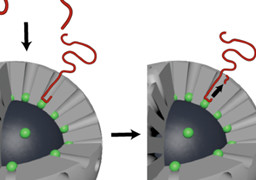




 |
 |
 |
|||
 |
 |
 |
 |
 | |
 |
 |
 | |


| 미디어 브리핑스 | 내서재담기 |


  |
 |  |
어떤 신기술이 세상을 극적으로 변화시킬까? 세계 최고의 연구소에서 나오는 놀라운 혁신을 독점 소개합니다.
플라스틱 재활용은 명백하게 ‘새로운 과학’은 아니다. 그러나 폐플라스틱은 더 낮은 등급의 덜 유용한 재료로 ‘다운 사이클(down-cycled)’되기 때문에 현재의 프로세스는 여전히 경제적으로 가치가 없다. 이는 현재의 플라스틱 재활용이 일회용 플라스틱으로 인해 증가하는 글로벌 오염 위기를 해결하는 길에 지속적인 장애물이 있음을 나타낸다.
하지만 미국 에너지부(Department of Energy)의 에임스 연구소(Ames Laboratory) 주도 하에 다양한 기관 과학자들로 구성된 연구팀이 폴리에틸렌(polyethylene) 및 폴리프로필렌(polypropylene)과 같은 폴리올레핀(polyolefin) 플라스틱을 처리할 수 있는 최초의 촉매를 개발했다. 이러한 유형의 폴리머는 플라스틱 식료품 백, 우유 용기, 샴푸 용기, 장난감 및 식품 용기와 같은 것들에 널리 사용되고 있는데 이들이 개발한 촉매를 통한 프로세스를 통해 연료, 용제, 윤활유를 생산하는 데 사용할 수 있는 균일한 고품질 성분을 생성해낼 수 있다. 연료, 용제, 윤활유는 높은 가치를 지닌다. 따라서 잠재적으로 이러한 플라스틱 및 기타 중고 플라스틱은 귀중한 미개발 자원으로 탈바꿈될 수 있다.
연구자들은 자연에서 빌려서 효소가 단백질과 셀룰로스와 같은 거대 분자를 정확하게 분해하는 과정을 모방할 수 있다고 가정했다. 이들이 개발한 독특한 공정은 나노 입자 기술을 통해서 나왔다.
연구자들은 긴 실리카 채널로 둘러싸인 촉매 ‘활성 부위’가 있는 백금 코어로 구성된 다공성(mesoporous) 실리카 나노 입자를 설계했는데, 이를 통해 긴 폴리머 사슬이 촉매에 연결된다. 이 설계를 통해 촉매는 더 긴 폴리머 사슬을 붙잡고 이를 더 유용한 새로운 최종 제품으로 업사이클(upcycled)될 가능성이 가장 큰 일관되고 균일한 짧은 조각으로 절단할 수 있다.
이러한 유형의 제어된 촉매 공정은 무기 물질을 기반으로 설계된 적이 없었다. 그리고 연구팀은 촉매 과정이 동일한 분자를 방출하기 전에 동일한 분자에 대해 여러 개의 동일한 분해 단계를 수행할 수 있음을 보여줄 수 있었다.
고체 NMR(nuclear magnetic resonance, 핵자기공명) 측정을 통해 연구팀은 원자 규모에서 촉매의 활동을 면밀히 조사하고 긴 폴리머 사슬이 촉매 채널을 통해 쉽게 이동하는지 확인할 수 있었다. 미 에너지부는 이 연구를 확장하여 계속 진행할 계획이다.
References
Nature Catalysis, October 12, 2020, “Catalytic upcycling of high-density polyethylene via a processive mechanism,” by Akalanka Tennakoon, et al. © 2020 Springer Nature Limited. All rights reserved.
To view or purchase this article, please visit:
Catalytic upcycling of high-density polyethylene via a processive mechanism chr(124)_pipe Nature Catalysis
https://www.nature.com/articles/s41929-020-00519-4
 |  |
Plastics recycling is definitely not “new science.” But current processes still don’t make it economically worthwhile because waste plastics get “down-cycled” into lower grade, less useful materials. This represents a continuing obstacle on the path to tackling the growing global pollution crisis caused by single-use plastics.
A multi-institutional team of scientists led by the U.S. Department of Energy’s Ames Laboratory has developed a first-of-its-kind catalyst that is able to process polyolefin plastics such as polyethylene and polypropylene. This type of polymer is widely used in things like plastic grocery bags, milk jugs, shampoo bottles, toys, and food containers. The process results in uniform, high-quality components that can be used to produce fuels, solvents, and lubricating oils; those products have a high value and could potentially turn these and other used plastics into a valuable untapped resource.
The researchers hypothesized that they could borrow from nature and mimic the processes by which enzymes precisely break apart macromolecules like proteins and cellulose. The unique process relies on nanoparticle technology.
They designed a mesoporous silica nanoparticle consisting of a core of platinum with catalytic “active sites,” surrounded by long silica channels, through which the long polymer chains thread through to the catalyst. With this design, the catalyst is able to hold on to and cleave the longer polymer chains into consistent, uniform shorter pieces that have the most potential to be upcycled into new, more useful end products.
This type of controlled catalysis process has never before been designed based on inorganic materials. And the team was able to show that the catalytic process is capable of performing multiple identical deconstruction steps on the same molecule before releasing it.
Solid-state NMR measurements allowed the team to scrutinize the catalyst’s activity at the atomic scale and confirm that the long polymer chains moved readily through the catalyst channels.
The Department of Energy plans to expand and continue this research.
References
Nature Catalysis, October 12, 2020, “Catalytic upcycling of high-density polyethylene via a processive mechanism,” by Akalanka Tennakoon, et al. © 2020 Springer Nature Limited. All rights reserved.
To view or purchase this article, please visit:
Catalytic upcycling of high-density polyethylene via a processive mechanism chr(124)_pipe Nature Catalysis
https://www.nature.com/articles/s41929-020-00519-4
